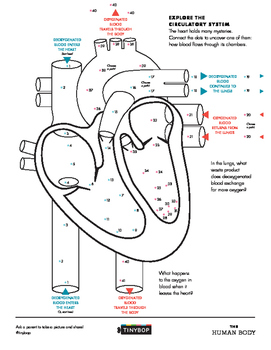Tinybop
850 Followers
Grade Levels
K - 9th
Subjects
Resource Type
Standards
CCSSRI.K.7
CCSSRI.1.7
CCSSRI.2.7
CCSSRI.3.7
CCSSRI.4.7
Formats Included
- PDF
Pages
1 page
Tinybop
850 Followers
Description
The heart holds many mysteries. Connect the dots to uncover one of them: how much blood flows through its chambers.
In the lungs, what waste product does deoxygenated blood exchange for more oxygen?
What happens to the oxygen in blood when it leaves the heart?
Aligned with Next Generation Science Standards (NGSS):
K-LS1-1. Use observations to describe patterns of what plants and animals (including humans) need to survive.
1-LS1-1. Use materials to design a solution to a human problem by mimicking how plants and/or animals use their external parts to help them survive, grow, and meet their needs.
4-LS1-1. Construct an argument that plants and animals have internal and external structures that function to support survival, growth, behavior, and reproduction.
MS-LS1-3. Use argument supported by evidence for how the body is a system of interacting subsystems composed of groups of cells.
HS-LS1-2. Develop and use a model to illustrate the hierarchical organization of interacting systems that provide specific functions within multicellular organisms.
HS-LS1-3. Plan and conduct an investigation to provide evidence that feedback mechanisms maintain homeostasis.
Copy and paste the following link to your browser to download the app:
https://itunes.apple.com/us/app/the-human-body-by-tinybop/id682046579?mt=8
In the lungs, what waste product does deoxygenated blood exchange for more oxygen?
What happens to the oxygen in blood when it leaves the heart?
Aligned with Next Generation Science Standards (NGSS):
K-LS1-1. Use observations to describe patterns of what plants and animals (including humans) need to survive.
1-LS1-1. Use materials to design a solution to a human problem by mimicking how plants and/or animals use their external parts to help them survive, grow, and meet their needs.
4-LS1-1. Construct an argument that plants and animals have internal and external structures that function to support survival, growth, behavior, and reproduction.
MS-LS1-3. Use argument supported by evidence for how the body is a system of interacting subsystems composed of groups of cells.
HS-LS1-2. Develop and use a model to illustrate the hierarchical organization of interacting systems that provide specific functions within multicellular organisms.
HS-LS1-3. Plan and conduct an investigation to provide evidence that feedback mechanisms maintain homeostasis.
Copy and paste the following link to your browser to download the app:
https://itunes.apple.com/us/app/the-human-body-by-tinybop/id682046579?mt=8
Total Pages
1 page
Answer Key
N/A
Teaching Duration
N/A
Report this resource to TPT
Reported resources will be reviewed by our team. Report this resource to let us know if this resource violates TPT’s content guidelines.
Standards
to see state-specific standards (only available in the US).
CCSSRI.K.7
With prompting and support, describe the relationship between illustrations and the text in which they appear (e.g., what person, place, thing, or idea in the text an illustration depicts).
CCSSRI.1.7
Use the illustrations and details in a text to describe its key ideas.
CCSSRI.2.7
Explain how specific images (e.g., a diagram showing how a machine works) contribute to and clarify a text.
CCSSRI.3.7
Use information gained from illustrations (e.g., maps, photographs) and the words in a text to demonstrate understanding of the text (e.g., where, when, why, and how key events occur).
CCSSRI.4.7
Interpret information presented visually, orally, or quantitatively (e.g., in charts, graphs, diagrams, time lines, animations, or interactive elements on Web pages) and explain how the information contributes to an understanding of the text in which it appears.


